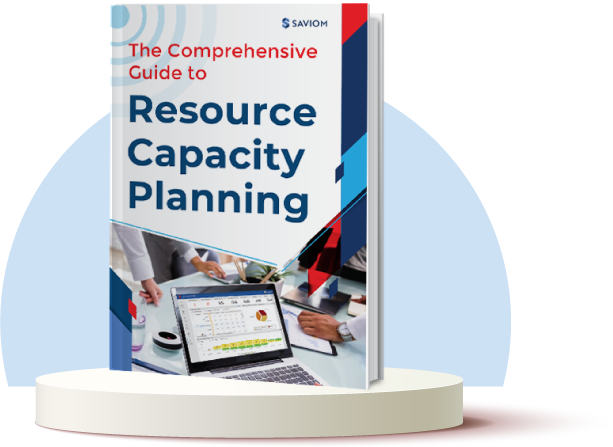Picture this: A high-value project has reached a 70% probability of closure in your sales pipeline. While it hasn’t been formally approved yet, it’s likely to move forward- which means you can’t afford to wait till the last minute to start resource planning.
To stay ahead, you begin by creating temporary bookings. These don’t represent specific individuals just yet, but they allow you to outline what the project will need in terms of people, roles, and expertise. Once the project is officially approved, these placeholders are replaced with resources matching the defined skillsets.
This is a classic use case of placeholders in project resource planning.
Placeholders act as temporary stand-ins for roles or resources that haven’t been finalized yet. They allow managers to define resource requirements, simulate various scenarios, and create the project schedule without needing all the details upfront. Whether you’re waiting for client approval or third-party vendor availability, placeholders allow you to continue project planning without pause.
In this blog, we will explore what a placeholder means, examine examples of how it works in practice, and understand its significance in project resource management.
Let’s get started!
What is a Placeholder?
A placeholder, also known as a generic or unnamed resource, is a stand-in resource used during the early stages of planning, typically when the project is still in the opportunity or approval pipeline. It represents a required role or skill set, as the suitable individual has not yet been identified or is unavailable.
Placeholders are used to create temporary, role-based assignments, allowing resource managers to move forward with planning, forecasting, and budgeting without delay. However, once the project is approved and real resources are available, placeholders can be seamlessly replaced with suitable personnel.
Now that we know what is a placeholder in scheduling; let us explore a few examples.
Example of Placeholders in Action
Given below are some industry-specific scenarios where placeholders help maintain momentum and prevent project delays.
Software Development Project
A cloud-based SaaS platform is in the proposal stage, and the delivery plan outlines the need for a front-end developer and a QA tester. Since allocation decisions are still pending, a resource manager decides to create and book placeholders using a typical naming convention like “ZZ_FrontEndDev” and “ZZ_QATester,” where “ZZ” simply indicates that the resource is generic.
These generic resources are assigned relevant skill sets, cost rates, and effort estimates, allowing accurate forecasting and capacity planning. Once the project is approved, these generic resources are seamlessly replaced with the most suitable employees for the required timeline.
AEC Industry Project
A construction company is planning a multi-story commercial building slated to begin next quarter. While the blueprint and scope are finalized, the actual workforce is still being sourced. To begin scheduling and budgeting, the project manager creates generic resources using a designated prefix along with the role name to clearly distinguish them from named resources.
Each generic resource is defined with key details such as required skills, certifications, hourly rates, and estimated effort. This enables the team to plan overall timelines, assess project interdependencies, and allocate budget realistically. Once hiring is complete or vendor contracts are finalized (and the resources are available), these ghost allocations are replaced with confirmed professionals.
Read More: The Art of Resource Planning Across Multiple Projects
Legal Contracts
A law firm is bidding for a major compliance case, and early resource planning is crucial to build a comprehensive proposal. The firm anticipates needing legal associates, a paralegal, and a document reviewer. However, these professionals are currently tied to ongoing engagements.
To keep planning on track, the manager creates generic resources, each mapped to the required qualifications, skill sets, and billing rates, aiding accurate capacity planning. That said, once qualified professionals become available, these placeholders are seamlessly replaced with actual legal personnel.
Now that we have a clear understanding of what is a placeholder and how they’re used in real-world scenarios, let’s explore their key benefits.
Benefits of Using a Placeholder in Resource Scheduling
Placeholders (or generic resources) enable organizations to streamline resource scheduling and ensure timely project initiation and execution. Let’s explore this in detail:
Enhance Project Resource Planning
By leveraging placeholders, managers can accurately plan project demand even when specific resources are unavailable or not finalized. They help define required roles, forecast availability, and simulate real assignments. This ensures resource planning doesn’t stall, allowing projects to stay on track from initiation through delivery.
Optimizes Capacity Planning
When actual resources are unavailable, placeholders represent unmet demand, providing managers with clear visibility during capacity planning. This enables firms to proactively apply resourcing measures, securing the right personnel to replace generic resources and ensuring a timely project onset.
Read More: 9 Effective Ways to Manage Capacity Planning Bottlenecks
Facilitates Competent Resource Allocation
Placeholders allow managers to define the required roles, skills, and cost expectations early in the planning stage. This clarity helps identify the best-fit resources as they become available. By replacing generic resources with the most suitable professionals, firms can ensure timely and competent allocation.
Read More: What is Resource Allocation, and Why is it Important?
Ensures Accurate Budget Estimation
A placeholder helps define expected roles, skill sets, and charge-out rates early in the planning stage. This allows managers to forecast project costs and prepare an accurate budget estimate even before assigning actual resources. Thus, when generic resources are eventually replaced, the project stays within financial expectations, minimizing the risk of budget overruns.
Read More: How to Develop an Effective Project Budget in 8 Simple Steps?
Prevents Project Delays
When a project reaches a certain probability of closure in the sales pipeline, the manager can begin planning the fulfillment activities. If resources are unavailable, placeholders are assigned to the project. Once actual resources become available, these ghost allocations are replaced, ensuring timely project initiation and preventing delays.
Now that we understand the benefits of generic resources, let’s explore how to use them effectively.
How to Use a Placeholder in Resource Scheduling?
Leveraging placeholders in resource scheduling ensures smooth project execution. Here’s a step-by-step process on how to use them effectively:
Assess Project Requirements
Managers must begin by evaluating the project scope, objectives, timeline, and budget. Further, firms should break down the project into key phases, tasks, dependencies, and milestones. This high-level assessment provides clarity on what needs to be done, helping set the groundwork for estimating resource demand in the next step.
Read More: What is Demand Management? 6 Key Steps to Get It Right
Determine the Roles and Skillsets
Based on the project breakdown, managers should identify the type, number, and quality of resources required for a specific duration. This includes outlining the necessary skills, competencies, experience levels, expertise, charge-out rate, etc., of resources needed to achieve project objectives. Clarity at this stage ensures accurate placeholder assignment.
Create Placeholders for Each Role
Once resource requirements are defined, managers should create placeholders corresponding to each role. These generic resources act as stand-ins until actual resources are assigned. For easy identification and deployment, organizations typically follow naming conventions such as using a “ZZ” prefix followed by the role name, e.g., ZZ_Developer or ZZ_Designer.

SAVIOM’s All-in-One Resource Planner displays placeholders based on the selected organizational dimension such as location, team, role, etc.
Allocate the Placeholders to Projects/Tasks
Managers should first assess the organizational talent pool to determine if they have sufficient internal capacity to meet upcoming project demands. However, in case of resource unavailability, firms can assign appropriately named generic resources to the relevant projects or tasks. This ensures project timelines are maintained without disruptions.
Convert Placeholders into Named Resources
Finally, to effectively manage resource shortages or unavailability, managers must implement suitable resourcing measures such as training, upskilling, out-rotation & backfill strategies, or engage in planned hiring, etc. These efforts help secure the right talent at the right time and cost. Once available, placeholders are replaced with named resources, ensuring timely project initiation and progress.
Now, let us move on to understand how next-gen resource management software can help organizations.
How Can Modern Resource Management Software Help?
5th Gen resource management software allows organizations to streamline planning, optimize resource allocation, and improve project efficiency. Let us explore the features in detail:
- The software’s all-in-one resource planner offers multidimensional analysis, enabling managers to view resources through various dimensions such as skills, team, location, role, department, named/generic resource, etc.
- Next, the embedded capacity planner helps actively predict resource shortages and excess, enabling organizations to take necessary resourcing measures ahead of time and avoid last-minute disruptions.
- Additionally, intelligent matchmaking helps replace the placeholders with the most suitable resources at optimal cost, enhancing both efficiency and organizational productivity.
Conclusion
Placeholders play a crucial role in proactive resource scheduling by allowing managers to plan, even when specific resources haven’t been identified. When used strategically, equipped with a 5th-generation resource management tool, organizations can streamline operations, minimize bottlenecks, achieve successful project outcomes, and ultimately drive higher ROI.
The Glossary
Read More: Glossary of Resource Workforce Planning, Scheduling and Management











